yeovil volunteers & Yeomanry
volunteers & Yeomanry
Recruits for the First World War
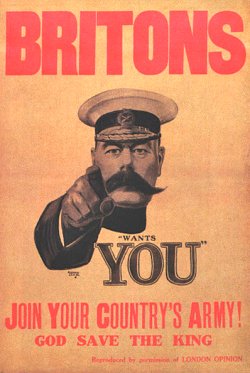 Created
on the
recommendation
of Secretary of
State for War,
Horatio
Kitchener, the
New Army, often
referred to as
Kitchener's Army
or,
disparagingly,
Kitchener's Mob
was initially an
all-volunteer
army formed as a
result of the
outbreak of
hostilities of
the First World
War in 1914.
Created
on the
recommendation
of Secretary of
State for War,
Horatio
Kitchener, the
New Army, often
referred to as
Kitchener's Army
or,
disparagingly,
Kitchener's Mob
was initially an
all-volunteer
army formed as a
result of the
outbreak of
hostilities of
the First World
War in 1914.
Due to the huge numbers of men wishing to sign up, long queues often formed outside recruitment offices. Almost 2.5 million men volunteered for Kitchener's Army and, among them, the men of Yeovil were quick to volunteer as the following photographs show.
A recruit accepted into the army was first sent to his Regimental depot, where he received his kit and was introduced to army discipline and training.
For most Yeovil volunteers this was in Taunton. Next the recruit was sent to the main training camps to join his battalion. In practice, no Regiment had the required stocks of equipment, or the manpower to train the flood of recruits; men trained wearing their own clothes and shoes.
Of the Yeovil recruits, over 300 would die in the war and hundreds more would suffer from wounds and illness.
For a list of
the 698 Yeovil
men who were in
service before 1
December 1914 -
click here.
For a list of
Yeovil men who
fell in the
Great War -
click here.
gallery

From my
collection
As soon as men began enlisting they would have their photograph taken as a keepsake for their families. This postcard by John Chaffin & Sons of Hendford, (probably of two Yeovil brothers about to go off to war) is typical of the period and several more are towards the bottom of this page.

From my
collection
A postcard of soldiers and horses outside of the Globe and Crown, South Street, Yeovil, possibly West Somerset Yeomanry billeted in the stable at the rear of the Globe and Crown whilst mustering for war service August 1914.

On 10 August 1914, just days before war was declared against Imperial Germany, 'D' Squadron of the West Somerset Yeomanry parade along High Street on their way to the Town Railway Station, en route to Winchester. Photograph by Walter Rendell.
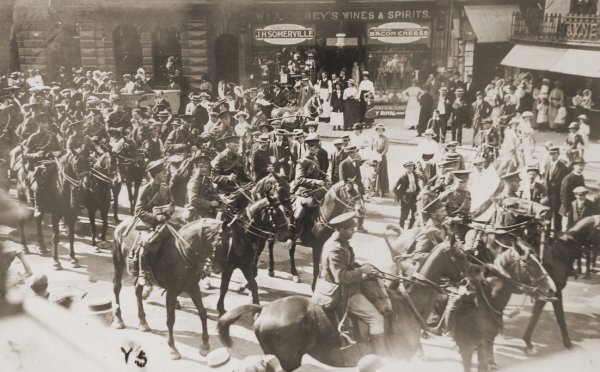
Courtesy of Jack
Sweet
'D' Squadron of the West Somerset Yeomanry pass through the Borough.
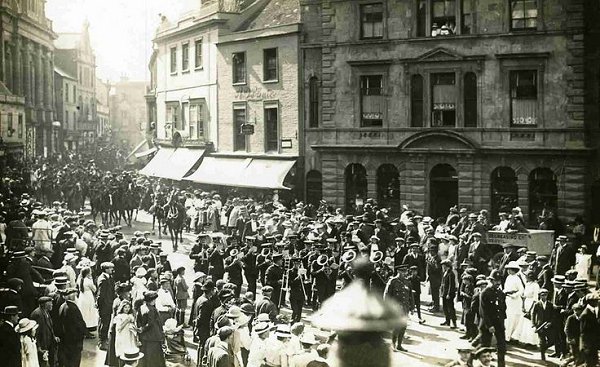
Volunteers parade through the Borough in 1914 preceded by a band and encouraged by large crowds of onlookers.

On Bank Holiday Monday, 4 August 1914, Yeovil men of 'E' (Yeovil) Company, 1st (West) Somerset Battalion of the National Reservists, known colloquially as the 'Straw Hat Brigade', line up in the Borough before marching to the Town Railway Station and travelling to Taunton. War was declared at midnight.
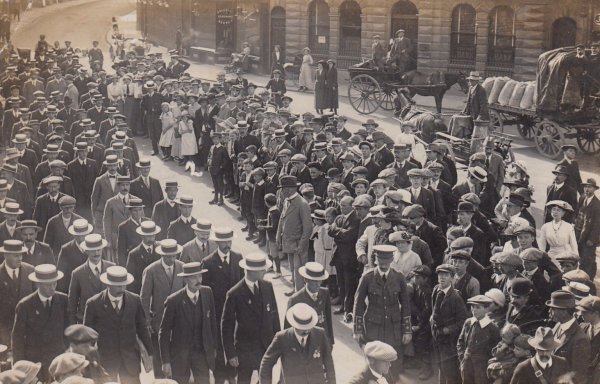
The 'Straw Hat Brigade' Yeovil Reservists of the previous photograph marching off from the Borough to the Town Station. Yeovilians known to be in this photograph include Stan Martin, Jim Phillips, William Phillips (who won the Military Medal at Ypres), Frank Albuit, Ed Curtis, Ern Bragg, J Welch, CJ Hook, EJ Farr (president of Yeovil Casuals and a former mayor), Everton Watts (son of former mayor Sidney Watts), G Fenwick (manager of the Corporation Gas Works), JA Mayo and J Bellamy (recruiting officer).
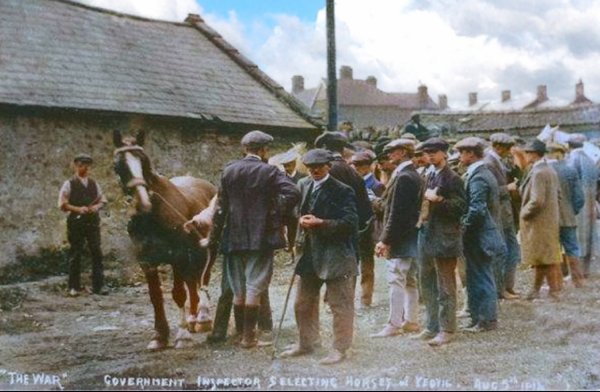
War Horses. The day after war was declared against Germany a Government inspector travelled to Yeovil to commandeer horses for use by the army. It has been estimated that the number of horses that served in the First World War was around six million, with a large percentage of them dying due to war-related causes. In 1914, estimates put Britain's horse population at between 20,000 and 25,000 and as well as requisitioning from British civilians, in order to meet its need for horses, Britain imported them from Australia, Canada, the USA, and Argentina.

Volunteers for Kitchener's army march down Lower Middle Street in September 1914, on their way to the Town Railway Station, accompanied by a local band and huge crowds of onlookers.

Same place, roughly the same time, but a different group of recruits.
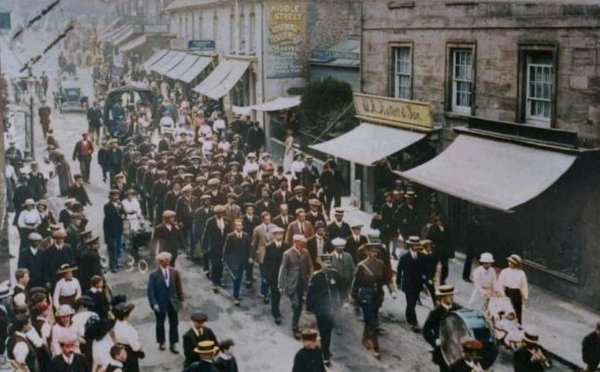
... and again in a colourised photograph of 1914.

With somewhat less celebration than the previous photograph, and led by their Recruiting Sergeant, more recruits march down Station Road to board a train at the Town Station. In the background, at extreme right, is the Railway Inn in Middle Street where the William Dampier stands today.
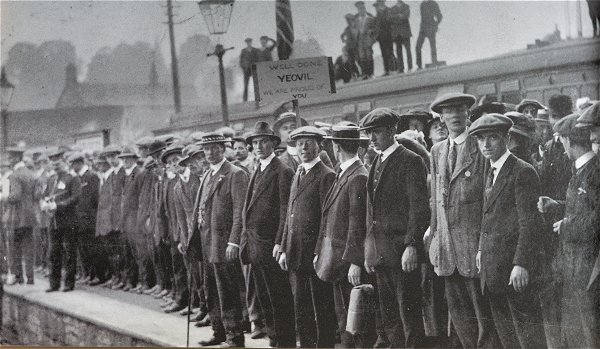
Yeovil recruits stand on the platform at the Town Station awaiting their train to Taunton in 1914. The sign on the roof of the railway carriage at centre rear states "Well done Yeovil, we are proud of you".

More volunteers, with their families, stand on the platform at the Town Station awaiting their train to Taunton in 1914.
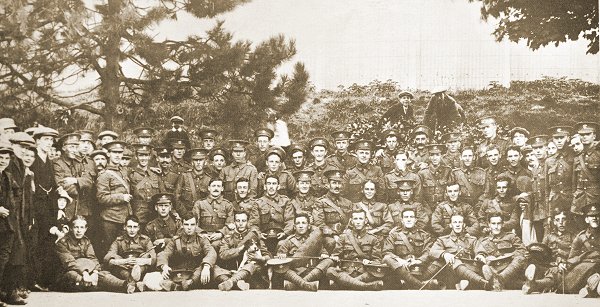
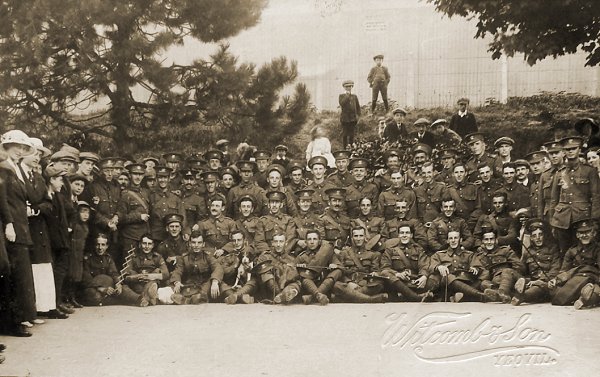
Courtesy of
Dinah Cheek
Two slightly different photographs by Witcomb & Son, Yeovil photographers, depicting men of the South Western Brigade Battalion, Territorial Force, photographed on 29 April 1915 on the forecourt of Pen Mill Station. This unit was raised in Yeovil from home service personnel, older or medically unfit men, classed as 'Category B'. In 1917 they became part of the 11th Battalion, Somerset Light Infantry, and saw action by August 1918 - fighting with such spirit that the Corps Commander ordered the 'B' category to be dropped.
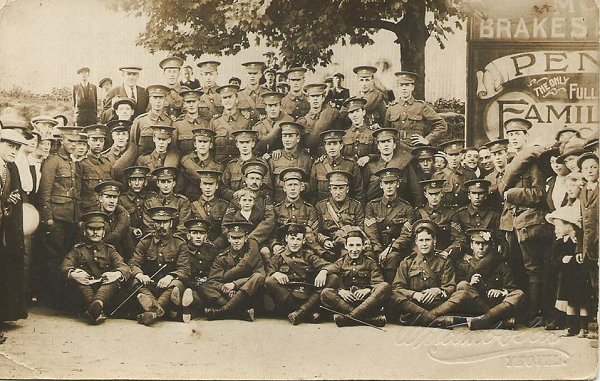
Courtesy of
Patricia Ann
Smith
Another photograph of departing troops on Pen Mill Station forecourt. This must have been somewhat later in the war since the soldier holding the small child just left of centre is known to be Rochford Maunder who, although enlisting as a regular in 1913, had achieved the rank of Sergeant by the time of this photograph. He was killed in action during the First Battle of Arras on 28 March 1918, aged 23.

Men of "Kitchener's Army" march down Middle Street on their way to the Western Front. Note Charles Hook's 'Golden Canister' shop at top centre and the entrance to Frederick Place at right. Photographed c1915.

A colourised photograph of the men of the Yeovil Cadet Corps and Boys' Brigade marching along Middle Street past the Railway Inn (at top left) around 1914.
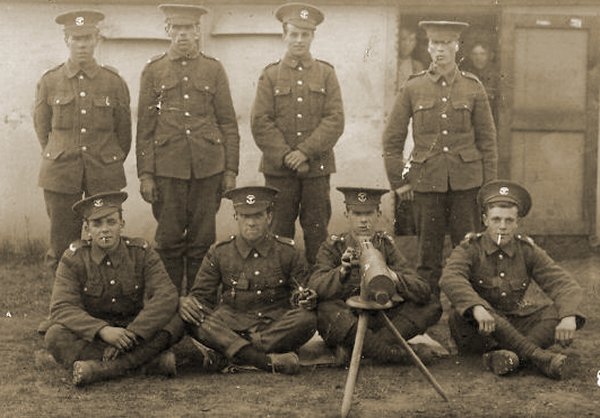
Men of the Somerset Light Infantry in training with a wooden mock-up machine-gun based on a Maxim gun.

Courtesy of
Steve Tucker
Gunners J Fulton of Cambuslang, Scotland, (seated) and Yeovil-born Alfred Tucker (1891-1965) of the Royal Field Artillery, c1914. After the war, Alfred lived in Seaton Road and worked at the WJ & EG Ricketts & Co glove factory in Addlewell Lane.
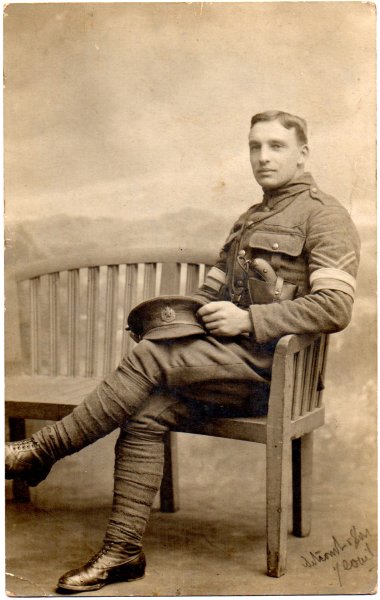
From my
collection
A Corporal of the Royal Engineers, home on leave in Yeovil, called in to Witcomb & Son's studio in Middle Street to have his photograph taken.
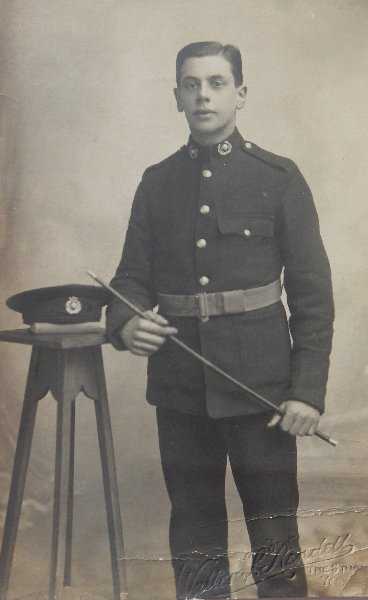
From my
collection
A studio portrait of a young lad off to war, by Walter Rendell.
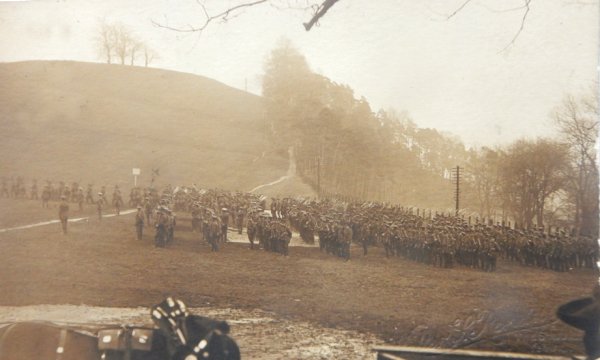
Courtesy of Jack
Sweet
The Territorial Composite Battalion parade for inspection in Wyndham Fields, 7 April 1915. Photographed by Walter Rendell.
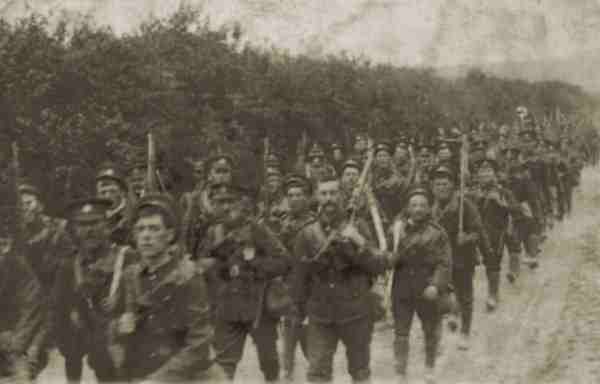
From my
collection
A photograph of marching soldiers by Yeovil photographer William Ross, produced as a postcard around 1915.
 |
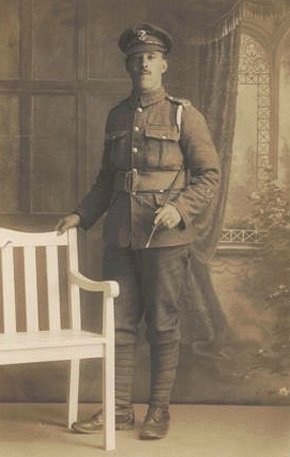 |
Two more studio
portraits of unknown
Yeovil
volunteers. The
soldier at right
was in the
Somerset Light
Infantry.
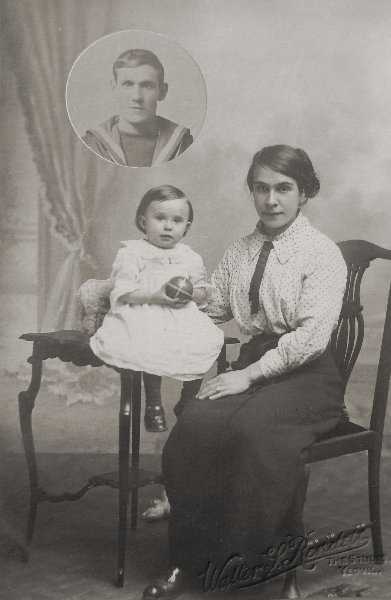
From my
collection
Perhaps her husband was at sea, or maybe he had died on active service, this studio portrait of a mother and child with the husband as an inset, was taken by Walter Rendall & Son.
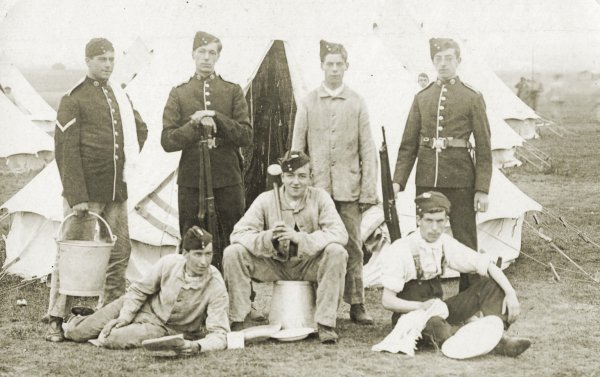
From my
collection
Off duty in a
training camp,
circa 1916.
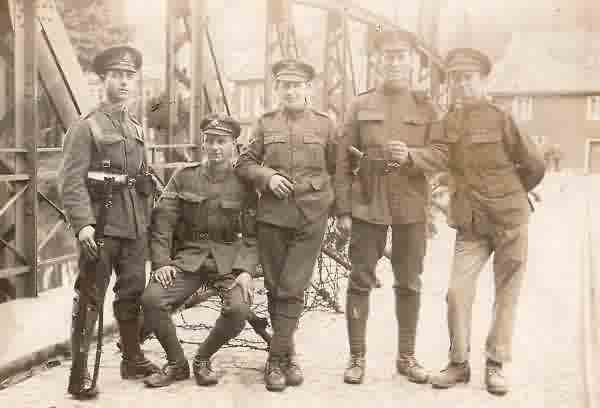
From my
collection
Not everyone came home to England immediately after the armistice - this photograph of British soldiers guarding a bridge in Germany was taken in 1919.